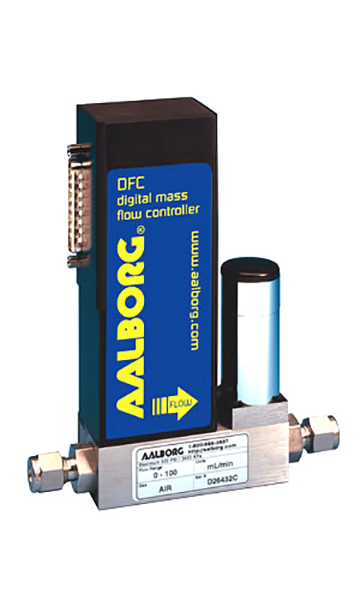DFC digital mass flow controller

DFC digital mass flow controller
Product Summary
DFC programmable thermal mass flow controller with digital signal processing
Design Features
- digital and analog modes operate
- programmable flow configurations
- available flow ranges starting from 0 to 10 sccm up to 0 to 100 slpm
- maximum pressure of 1000 psig (70 bars)
- multi-drop capability of up to 256 units
- stores calibration data for up to 10 gases
- totalizer indicates total gas quantity
- alarm limits for high and low gas flow
- conversion factors for up to 256 gases
- auto tune function for optimum control response
- self diagnostic tests
Microprocessor driven digital flow controllers allow one to program, record, and analyze flow rates of various gases with a computer via an RS-485 interface (optional RS-232 is available).
Controllers can be programmed for various control functions including flow set point, totalizer, stop totalizer, read totalizer, totalizer from preset flow, stop at preset total, auto zero, and more.
Principles of Operation
Metered gases are divided into two laminar flow paths, one through the primary flow conduit, and the other through a capillary sensor tube. Both flow conduits are designed to ensure laminar flows and therefore the ratio of their flow rates is constant. Two precision temperature sensing windings on the sensor tube are heated, and when flow takes place, gas carries heat from the upstream to the downstream windings. The resultant temperature differential is proportional to the change in resistance of the sensor windings.
A Wheatstone bridge design is used to monitor the temperature dependent resistance gradient on the sensor windings which is linearly proportional to the instantaneous rate of flow. The output of the Wheatstone bridge is converted to digital format with a 12 Bit ADC (analog to digital converter).
An on-board microprocessor and nonvolatile memory store all calibration factors and directly control a proportionating electromagnetic valve. The digital closed loop control system continuously compares the mass flow output with the selected flow rate. Deviations from the set point are corrected by compensating valve adjustments, with PID algorithm thus maintaining the desired flow parameters with a high degree of accuracy. Output signals of 0 to 5Vdc or 4 to 20mA are generated indicating mass molecular based flow rates of the metered gas.